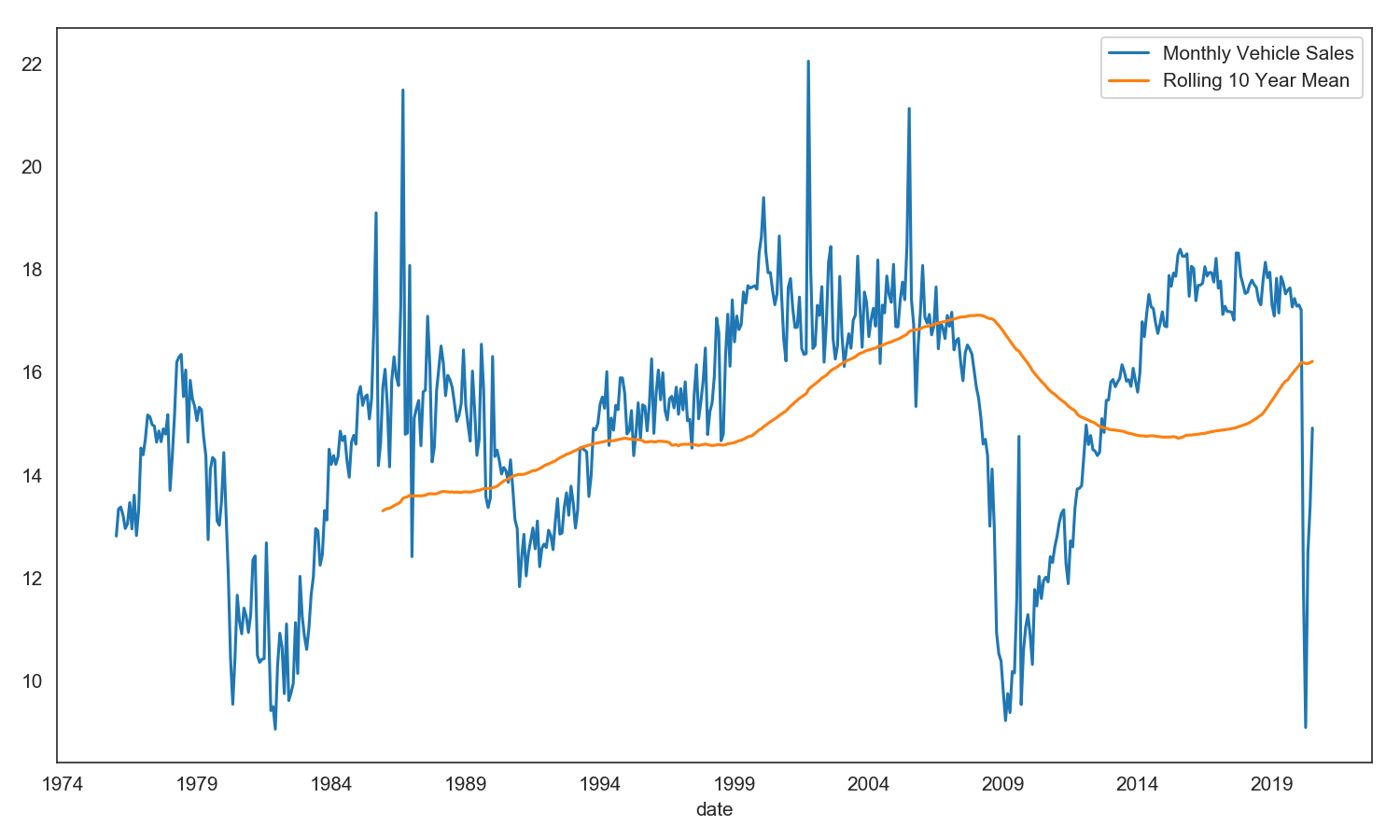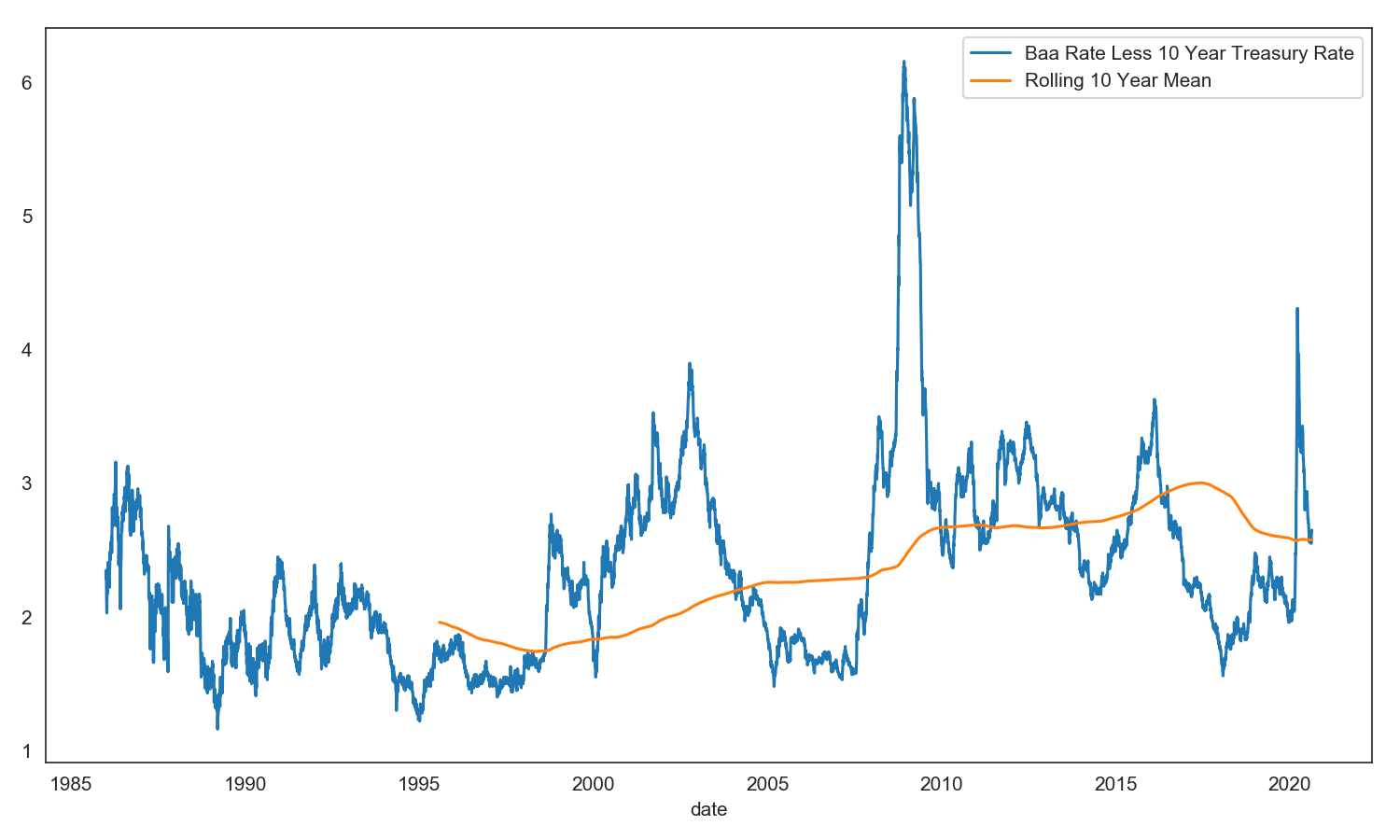微信支付商業版 結算周期
Economics is an inexact science, finance and investing even more so (some would call them art). But if there’s one thing in economics that you can consistently count on over the long run, it’s the tendency of things to mean revert thanks to the business cycle.
經濟學是一門不精確的科學,金融和投資更是如此(有人稱它們為藝術)。 但是,如果從長遠來看,經濟學中有一件事可以一貫地指望著,那就是由于商業周期的緣故,事物趨于恢復的趨勢。
You’ve probably heard of the Law of Large Numbers. It states that when we run an experiment a large number of times, the average of the results tend towards the expected value (a.k.a. the mean). In economics and finance, which deal more with time-series data, there’s also a tendency, albeit weaker, for the data to revert towards its long-term mean. For example, look at the way the unemployment rate ebbs and flows across economic cycles, but regularly comes back to its mean (the orange line):
您可能聽說過大數定律。 它指出,當我們進行大量實驗時,結果的平均值趨向于期望值(即平均值)。 在經濟學和金融學中,它們更多地處理時間序列數據,盡管這種趨勢較弱,但也存在一種趨勢,即數據會恢復其長期均值。 例如,看一下失業率在整個經濟周期中起伏波動的方式,但是經常回到平均值(橙色線):

Of course this is different from the law of large numbers where the idea is that we’re repeating the same experiment over and over. In economics, things are never the same — many of the forces driving things a decade ago are often significantly different today. Thus, the magnitude and pace of mean reversion can vary over time. Additionally, the exact value of the mean is also uncertain and could potentially change over time.
當然,這與大數定律不同,大數定律的思想是我們要一遍又一遍地重復相同的實驗。 在經濟學上,情況從來都不是一樣的-十年前推動事物發展的許多力量如今通常大不相同。 因此,均值回歸的幅度和步伐會隨時間變化。 此外,平均值的確切值也不確定,并且可能隨時間變化。
And yet, the most powerful forces that drive the business cycle are reasonably consistent, which explains why despite constant change many economic variables like unemployment still tend to reliably mean revert:
然而,驅動商業周期的最強大力量在一定程度上是一致的,這解釋了為什么盡管不斷變化,失業等許多經濟變量仍然傾向于可靠地意味著恢復:
- Though the federal reserve may skew dovish or hawkish depending on who’s at the helm (with a heavy bias towards dovish), its mandate is to steer the economy towards full employment (and stable inflation) using monetary policy. The Fed generally prefers steady economic growth, low unemployment, and rising asset prices. The reason rising asset prices (especially real estate) is preferred is because it begets credit expansion (rising asset values drives lending via healthier bank balance sheets, demand for debt, and more loan collateral), a critical component of economic growth. 盡管美聯儲可能會偏向鴿派或鷹派,取決于誰在掌權(偏向鴿派),但其任務是使用貨幣政策引導經濟朝著充分就業(以及穩定的通脹)方向發展。 美聯儲普遍傾向于穩定的經濟增長,低失業率和資產價格上漲。 首選資產價格上漲(尤其是房地產價格上漲)的原因是,它會引發信貸擴張(資產價值上升通過更健康的銀行資產負債表,債務需求以及更多的貸款抵押品來驅動貸款),這是經濟增長的關鍵組成部分。
- The U.S. government is also heavily incentivized to get people employed (happy citizens, better approval ratings, and more tax revenue) via fiscal stimulus. 美國政府也受到了很大的激勵,希望通過財政刺激措施來雇用人們(快樂的公民,更好的批準率以及更多的稅收收入)。
- Over-investment and excessive job growth in an over-heating industry or economy ultimately self-corrects — too much supply and competition (often accompanied by a demand shock) push down prices and profits. And the businesses that joined the party too late often end up bankrupt. 過熱的行業或經濟中的過度投資和過度的工作增長最終會自我糾正-過多的供應和競爭(通常伴隨著需求沖擊)壓低了價格和利潤。 加入黨太晚的企業往往破產。
- During times of below average unemployment (tight labor market), high salary growth pushes up inflation. If inflation rises enough for the Fed to start raising interest rates, then this also serves to slow economic growth (by slowing down credit growth — less credit, a.k.a. borrowing, means less money in everyone’s pockets and less consumer spending). Often, the Fed ends up raising rates one too many times pushing the economy into recession and unemployment up past its mean. 在失業率低于平均水平(勞動力市場緊張)的時期,高工資增長會推高通脹。 如果通脹上升到足以使美聯儲開始加息的水平,那么這也將減緩經濟增長(通過放慢信貸增長-減少信貸,又名借款,意味著每個人的口袋里的錢減少和消費者支出的減少)。 通常,美聯儲最終會多次加息,從而使經濟陷入衰退,失業率超過平均水平。
- A beaten down industry or economy eventually recovers. Once the excess supply has been removed (via defaults or consolidation), the price wars cease and companies can earn a reasonable return on their investment again. This, along with the impacts of expansionary monetary and fiscal policy, cause a new wave of economic expansion and unemployment declines. 遭受重創的行業或經濟最終將復蘇。 一旦消除了多余的供應(通過違約或合并),價格戰便會停止,公司可以再次獲得合理的投資回報。 這與擴張性的貨幣和財政政策的影響一起,引起了新一輪的經濟擴張和失業率下降。
周期 (The Cycle)
Before we look at more variables that are impacted by the cycle, let’s map out its approximate shape and driving forces:
在查看更多受周期影響的變量之前,讓我們先繪制出其近似形狀和驅動力:

Each cycle is different, the industries that drive the excess are rarely the same — in the late 1990s it was Dotcom, during 2005–2008 it was housing and banks. But the forces at play are similar:
每個周期都不同,導致過剩的行業很少相同–在1990年代后期是Dotcom,在2005-2008年期間是住房和銀行。 但是作用的力量是相似的:
過熱 (Overheating)
A tight labor market along with strong corporate profits and investment spending drive wage growth and credit growth, which leads to lots of dollars flying around and inflation. This spurs interest rate increases (by the Federal Reserve).
緊張的勞動力市場以及強勁的公司利潤和投資支出推動工資增長和信貸增長,從而導致大量資金流失和通貨膨脹。 這刺激了利率上升(美聯儲)。
經濟衰退 (Recession)
Higher interest rates hurt asset prices and make borrowing less attractive — the net effect is less spending, less economic growth, job losses, and ultimately recession (but no more inflation).
較高的利率會損害資產價格,并使借貸的吸引力降低-最終的結果是支出減少,經濟增長減少,工作機會減少,最終導致衰退(但通貨膨脹率卻沒有增加)。
復蘇 (Recovery)
Once inflation is under control, the Fed is able to focus on its full employment mandate, and lower interest rates and/or print money (quantitative easing) with the aim of stimulating credit growth and asset prices. Often, expansionary monetary policy is accompanied by fiscal stimulus from the government as well — lowering rates on its own is usually not enough to reverse a severe recession.
一旦通貨膨脹得到控制,美聯儲便可以專注于其全部就業任務,并降低利率和/或印制貨幣(量化寬松),以刺激信貸增長和資產價格。 通常,擴張性貨幣政策還伴隨著政府的財政刺激措施-單靠降低利率通常不足以扭轉嚴重的衰退。
And with many of their competitors gone and their operations leaner, surviving businesses gradually return to making money and begin hiring again.
隨著許多競爭對手的消失和業務的精簡,幸存的企業逐漸恢復賺錢并重新開始招聘。
And the cycle begins anew…
周期又開始了……
通過經濟變量觀察周期 (Observing The Cycle Through Economic Variables)
Earlier we saw how the cycle causes unemployment to ebb and flow — though it’s probably more accurate to think of the unemployment rate as a major driver of the cycle (employment generally lags economic growth, but has a major feedback impact on most major economic variables).
早些時候,我們看到了周期如何導致失業潮起潮落—盡管將失業率視為周期的主要驅動因素可能更準確(就業通常滯后于經濟增長,但對大多數主要經濟變量具有重要的反饋影響) 。
What are some other ones? The year-over-year change in industrial production (which is highly correlated to GDP) is another one. Notice how the blue line remains above the orange line when the economy is growing and pierces below it during recessions. Also observe the current low value, which hints at the shrinkage in the economy due to the ongoing pandemic. The good news is that it’s already begun to mean revert, but it’s still a long ways below what we would expect of a healthy and expanding economy.
還有什么? 工業生產的逐年變化(與GDP高度相關)是另一種變化。 請注意,當經濟增長時,藍線如何保持在橙色線之上,而在經濟衰退期間,藍線會跌破橙色線。 還要注意當前的低值,這暗示著由于持續的大流行而導致的經濟萎縮。 好消息是它已經開始意味著恢復,但距離我們對健康和不斷發展的經濟的期望還差很遠。

Keep in mind that despite the tendency to revert towards the mean, the data rarely stays at the mean for very long. So you shouldn’t think of the mean as a level that you will frequently observe in the future.
請記住,盡管有趨向于均值的趨勢,但數據很少會長時間停留在均值上。 因此,您不應將平均值視為將來會經常觀察到的水平。
I added total monthly vehicle sales as well — vehicle sales are also very sensitive to the economic cycle as people tend to put off large purchases when the economy is not doing well. Notice how close the blue line is to coming back to the orange line. This means that despite the pandemic, the current pace of vehicle sales is almost back to what could be considered a normal level.
我還增加了每月的汽車總銷售量,汽車銷售對經濟周期也非常敏感,因為人們在經濟狀況不佳時往往會推遲購買大筆商品。 請注意,藍線與回到橙色線的距離有多近。 這意味著,盡管出現了大流行,但當前的汽車銷售速度幾乎已恢復到正常水平。

A favorite one of mine to watch is credit spreads, which measures the extra yield that lenders demand to bear bankruptcy risk. It’s the difference between the interest rate on corporate bonds (Baa is the lowest rating that’s still investment grade) and the interest rate on safe bonds (U.S. Treasury bonds). I like it because it’s a function of both what’s been going on recently (have a lot of companies been defaulting?) and the bond market’s expectations of the future (will a lot of companies start defaulting over the next few years?). It’s a good gauge of the market’s appetite for risk — below average yields implies that investors believe everything is great and above average yields mean that investors are panicking or close to it.
值得關注的礦山之一是信用點差,它可以衡量貸方要求承擔破產風險的額外收益。 這是公司債券的利率(Baa是仍為投資級別的最低評級)與安全債券的利率(美國國庫券)之間的差。 我之所以喜歡它,是因為它既是最近正在發生的事情(有很多公司正在違約嗎?)又是債券市場對未來的期望(在未來幾年內很多公司會開始違約嗎?)的函??數。 這是衡量市場風險偏好的良好指標-低于平均收益率意味著投資者認為一切都很好,而高于平均收益率則意味著投資者感到恐慌或接近風險。
It looks like investors were pretty panicked a few months ago but have largely calmed down since then.
幾個月前,投資者似乎感到非常恐慌,但此后基本上平靜下來了。

One thing we can do is look at the de-trended version of each time series — to remove the trend, we just subtract the mean (the blue line less the orange line). Let’s overlay the de-trended (and Z-scored) variables on top of each other to see how they relate:
我們可以做的一件事是查看每個時間序列的去趨勢版本-要刪除趨勢,我們只減去均值(藍色線減去橙色線)。 讓我們將去趨勢的(和Z評分的 )變量相互疊加,以了解它們之間的關系:

We can see that the series do generally move together, though unemployment clearly lags the other two. As I mentioned earlier, unemployment generally lags other economic data because businesses tend to be slow to fire and slow to rehire (as they feel their way through the business cycle in real-time). The current pandemic is an exception where involuntary shutdowns forced thousands of businesses to close and millions of people into unemployment virtually overnight — so there’s no lag this time around.
我們可以看到,盡管失業率明顯落后于其他兩個國家,但總體而言,這兩個系列確實在一起。 正如我前面提到的,失業率通常落后于其他經濟數據,因為企業往往開火慢,招聘慢(因為他們實時地感覺到整個商業周期的方式)。 當前的流行病是一個例外,非自愿關閉迫使數千家企業關閉,數百萬人幾乎在一夜之間陷入失業-因此這次沒有滯后。
If you find it hard to tell that they’re correlated from the previous graph, below is the correlation matrix. Vehicle sales and industrial production are highly correlated (note that industrial production and vehicle sales have been inverted to make them directionally consistent with unemployment — so when vehicle sales appears high in the plot, it actually denotes a below average value). Unemployment appears less correlated because it moves with a lag compared to the other two variables (if we lagged the unemployment time series by a few months, we would see a much higher correlation).
如果您很難從上一張圖中看出它們之間是相關的,則下面是相關矩陣。 汽車銷售和工業生產高度相關(請注意,工業生產和汽車銷售已經倒置,使其與失業在方向上保持一致,因此,當圖中汽車銷售出現高位時,實際上表示低于平均值)。 與其他兩個變量相比,失業與失業的相關性似乎較低(如果我們將失業時間序列滯后幾個月,則相關性會更高)。

Lastly, we can take a look at how spreads, which include the investment market’s expectations (which can be very inaccurate) of the future relate to the average of the three macroeconomic variables we plotted earlier (the time series are plotted as Z-scores).
最后,我們可以看一下點差,其中包括投資市場對未來的期望(可能非常不準確)與我們之前繪制的三個宏觀經濟變量的平均值的關系(時間序列繪制為Z得分) 。

They generally move together (correlation=0.63). That’s one of the dirty secrets of finance — variables that are supposed to be forward-looking because they are based on market prices (and the way markets supposedly embed and capture all the available information) are actually pretty reactive. Meaning that they move in tune (or even slightly behind) economic data, and almost never ahead of it. True shocks happen out of the blue and pretty much always blindside investors.
它們通常一起移動(相關系數= 0.63)。 那是金融的骯臟秘密之一-變量應該是前瞻性的,因為它們基于市場價格(以及市場嵌入和捕獲所有可用信息的方式)實際上是相當被動的。 這意味著它們會與經濟數據保持一致(甚至略微落后),幾乎永遠不會超前。 真正的沖擊出人意料,幾乎總是盲目的投資者。
One interesting thing is how differently corporate bond investors view 2008 vs. today. Despite a similar sized negative shock to the economy, credit spreads barely budged during this pandemic and have already recovered back to the rolling 10 year mean. Back in 2008, the initial shock to credit spreads was much larger and the recovery took longer.
一件有趣的事情是,公司債券投資者對2008年和今天的看法有何不同。 盡管對經濟造成了類似規模的負面沖擊,但在這種大流行期間,信用利差幾乎沒有變化,已經恢復到滾動的10年平均值。 早在2008年,信貸利差的最初沖擊就更大了,復蘇所需的時間更長。
結論 (Conclusion)
Macroeconomics is a very deep subject and this post only scratches the surface of the business cycle. Even though I titled it “Understanding The Business Cycle”, I doubt anyone reading this without prior knowledge and experience would come out of it with a deep understanding of the business cycle. Rather, it’s more critical that you recognize that the business cycle exists — and that it’s responsible for much of the ebb and flow of our economic and financial lives.
宏觀經濟學是一個非常深入的主題,這篇文章僅涉及商業周期的表面。 即使我將其標題為“了解商業周期”,但我懷疑任何在沒有先驗知識和經驗的情況下閱讀本文的人都會對商業周期有深刻的了解。 相反,更重要的是,您要認識到存在商業周期,并且它對我們的經濟和金融生活的起伏不定負有責任。
When I think of the business cycle, it reminds me of that old saying, “History doesn’t repeat itself, but it often does rhyme”. Keeping that in mind, we should not only recognize the existence of the business cycle, but also put at least some effort and thought towards preparing for the next phase of the cycle while we’re still in the current one. Cheers!
當我想到經濟周期時,它使我想起了那句老話:“歷史不會重演,但通常會押韻。” 牢記這一點,我們不僅應該認識到業務周期的存在,而且還應該付出至少一些努力和思想,以便在我們仍處于當前周期的同時為周期的下一階段做準備。 干杯!
翻譯自: https://towardsdatascience.com/understanding-the-business-cycle-79794263d49b
微信支付商業版 結算周期
本文來自互聯網用戶投稿,該文觀點僅代表作者本人,不代表本站立場。本站僅提供信息存儲空間服務,不擁有所有權,不承擔相關法律責任。 如若轉載,請注明出處:http://www.pswp.cn/news/391838.shtml 繁體地址,請注明出處:http://hk.pswp.cn/news/391838.shtml 英文地址,請注明出處:http://en.pswp.cn/news/391838.shtml
如若內容造成侵權/違法違規/事實不符,請聯系多彩編程網進行投訴反饋email:809451989@qq.com,一經查實,立即刪除!

)

)

)









...)


